unity代码创建mesh
来源:互联网 发布:用单片机实现红绿灯 编辑:程序博客网 时间:2024/04/29 11:17
简介 Introduction
这个教程将让你学会如何创建一个星型控件以及如何制作这个控件的自定义编辑器。你将学会:
我们假设你已经学会了Unity C#的基础编程知识,以及Unity 编辑器的基础知识。如果你已经完成了相关的学习,Let's Go!
建立Star类 Creating the star
我们建立一个全新的Unity工程,然后建立一个新的C#脚本,将它命名为Star。我们将用这个脚本,建立一个由三角面拼接成的星,这里需要一个Mesh。
什么是Mesh?
3D模型是由多边形拼接而成,一个复杂的多边形,实际上是由多个三角面拼接而成。所以一个3D模型的表面是由多个彼此相连的三角面构成。三维空间中,构成这些三角面的点以及三角形的边的集合就是Mesh。
using UnityEngine; public class Star : MonoBehaviour { private Mesh mesh; }
任何对于Mesh的使用,都必须搭配一个MeshFilter组件,而MeshFilter又被用于MeshRenderer组件。只有这样,才能被Unity绘制。所以,这些组件都必须被加载到GameObject对象上,我们的Star对象也必须这么做。当然,我们可以手动添加这些组件,但默认的自动添加是一个更好的办法。所以我们需要添加一个RequireComponent类作为Star对象的一个特性。
什么是类的特性?
特性像对类附加一个标签,用来告诉编译器这个类需要如何处理。是除了类声明的代码之外,对类做的附加说明。另外,特性不止针对类,对方法和属性同样适用。
typeof有什么用?
typeof是一种运算符,能够获得任何类的类型描述数据,数据里最常用的就是类的名字。那为什么不直接在代码里写类的名字就好呢?因为代码中所有的赋值和运算都需要变量,直接使用类的名字会导致编译错误。
using UnityEngine; [RequireComponent(typeof(MeshFilter), typeof(MeshRenderer))] public class Star : MonoBehaviour {
private Mesh mesh;
}
现在,我们建立一个新的空GameObject,将它命名为My First Star,然后拖拽我们的脚本Star到My First Star上。你可以看到,My First Star拥有了两个组件,MeshRenderer和Star。
拖动一个,得到三个
下一个步骤是建立一个Mesh。我们需要在Unity的Start事件里来做这些事,Start事件将在程序启动的时候发生。我们还需要在MeshFilter中给这个新的Mesh起一个名字。
using UnityEngine;
[RequireComponent(typeof(MeshFilter), typeof(MeshRenderer))]
public class Star : MonoBehaviour {
private Mesh mesh; void Start () { GetComponent<MeshFilter>().mesh = mesh = new Mesh(); mesh.name = "Star Mesh"; } }


无编辑器模式与实时预览模式
当然,现在我们在预览模式下还看不到任何东西,因为Mesh还是空的。所以让我们开始编辑顶点数组吧,我们的Star类需要一个用来设置顶点数量的属性,以及这些定点与中心的相对距离。
第一个顶点是Star的中心点,其余的顶点将顺时针排列。我们将使用四元数来计算这些点的排列。因为我们假设俯视Z轴,所以,轮转的角度是负数,否则,将使这些点做逆时针排列。我们不需要设置第一个点,因为vector默认会被设置成0, Mesh中使用本地坐标系。
using UnityEngine;
[RequireComponent(typeof(MeshFilter), typeof(MeshRenderer))]
public class Star : MonoBehaviour { public Vector3 point = Vector3.up; public int numberOfPoints = 10; private Mesh mesh; private Vector3[] vertices; void Start () {
GetComponent<MeshFilter>().mesh = mesh = new Mesh();
mesh.name = "Star Mesh"; vertices = new Vector3[numberOfPoints + 1]; float angle = -360f / numberOfPoints; for(int v = 1; v < vertices.Length; v++){ vertices[v] = Quaternion.Euler(0f, 0f, angle * (v - 1)) * point; } mesh.vertices = vertices; }
}

新的编辑器属性
三角面会被保存成顶点数组,每个面三个顶点。因为我们使用三角形来描述多边形,每个三角形都起始于相同的中点,并且与其他的三角形相连。最后一个三角形与第一个三角形相连。例如,如果有四个三角形,那么顶点数组如下{0, 1, 2, 0, 2, 3, 0, 3, 4, 0, 4, 1}。
using UnityEngine;
[RequireComponent(typeof(MeshFilter), typeof(MeshRenderer))]
public class Star : MonoBehaviour {
public Vector3 point = Vector3.up;
public int numberOfPoints = 10;
private Mesh mesh;
private Vector3[] vertices; private int[] triangles; void Start () {
GetComponent<MeshFilter>().mesh = mesh = new Mesh();
mesh.name = "Star Mesh";
vertices = new Vector3[numberOfPoints + 1]; triangles = new int[numberOfPoints * 3]; float angle = -360f / numberOfPoints;
for(int v = 1, t = 1; v < vertices.Length; v++, t += 3){
vertices[v] = Quaternion.Euler(0f, 0f, angle * (v - 1)) * point; triangles[t] = v; triangles[t + 1] = v + 1; } triangles[triangles.Length - 1] = 1; mesh.vertices = vertices; mesh.triangles = triangles; }
}
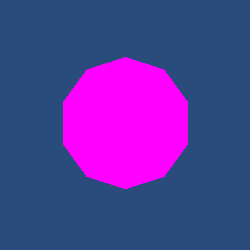
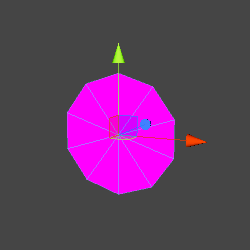
一个简单的星星
现在,我们的星星看起来还只是一个简单的多边形。Unity也提示说丢失材质坐标,因为默认的Shader需要这些坐标。我们不会使用一个纹理来描绘所有的星星,让我们通过建立我们自己的Shader来消除这个警告,这个Shader将只使用顶点着色。
我们建立一个新的Shader将它命名为Star,然后写入以下代码。
什么是CGPROGRAM?
Basically, data flows from the Unity engine into the graphics card, where it's processed per vertex. Then interpolated data flows from the vertices down to the individual pixels. In this case, we pass position and color data all the way down. The only additional thing we do is convert vertex positions from world space to screen space.
The statements above the CGPROGRAM switch off default lighting and depth buffer writing. Culling is switched off so we can see the triangles from both sides, not just the front. "Blend SrcAlpha OneMinusSrcAlpha" is default alpha blending, allowing for transparency.
为什么不使用fixed-function shader?
fixed-function shader已经属于过时的技术了。 CGPROGRAM 在将数据转化成屏幕像素方面拥有更强大的功能。
Shader "Star"{
SubShader{
Tags{ "Queue"="Transparent" "IgnoreProjector"="True" "RenderType"="Transparent"}
Blend SrcAlpha OneMinusSrcAlpha
Cull Off
Lighting Off
ZWrite Off
Pass{
CGPROGRAM
#pragma vertex vert
#pragma fragment frag
struct data {
float4 vertex : POSITION;
fixed4 color: COLOR;
};
data vert (data v) {
v.vertex = mul(UNITY_MATRIX_MVP, v.vertex);
return v;
}
fixed4 frag(data f) : COLOR {
return f.color;
}
ENDCG
}
}
}
现在我们建立一个新的材质球,命名为Star,将Shader设置为我们刚刚编写的Star,并且将这个材质球赋予My First Star。
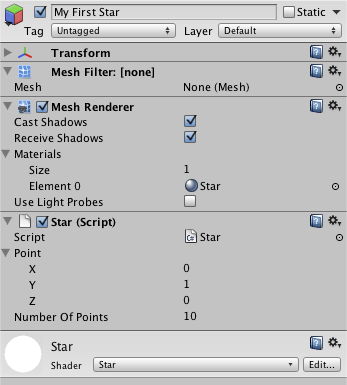
添加材质球之后
顶点着色默认是白色,所以我们的多边形现在变成了白色。我们想要一个更漂亮的星星。所以我们来为每个点定义一种颜色。我们再添加一个frequency属性,这样我们就能让程序自动重复点的序列,而不用我们逐个定义全部的点。这个选项取代了numberOfPoints。
我们在最后需要确认frequency属性是否正确,并且星星至少拥有一个点。如果没有,我们的代码就可能出错。
Why check both for null and the length?
When freshly created, our star component won't have an array yet. It's also technically possible for scripts to explicitly set our array to null later on. We need to watch out for that, to prevent errors. Only if the array does exists do we go ahead and check its length as well.
using UnityEngine;
[RequireComponent(typeof(MeshFilter), typeof(MeshRenderer))]
public class Star : MonoBehaviour { public Vector3[] points; public int frequency = 1; private Mesh mesh;
private Vector3[] vertices;
private int[] triangles;
void Start () {
GetComponent<MeshFilter>().mesh = mesh = new Mesh();
mesh.name = "Star Mesh"; if(frequency < 1){ frequency = 1; } if(points == null || points.Length == 0){ points = new Vector3[]{ Vector3.up}; } int numberOfPoints = frequency * points.Length; vertices = new Vector3[numberOfPoints + 1];
triangles = new int[numberOfPoints * 3];
float angle = -360f / numberOfPoints;
for(int iF = 0, v = 1, t = 1; iF < frequency; iF++){ for(int iP = 0; iP < points.Length; iP += 1, v += 1, t += 3){
vertices[v] = Quaternion.Euler(0f, 0f, angle * (v - 1)) * points[iP];
triangles[t] = v;
triangles[t + 1] = v + 1; } }
triangles[triangles.Length - 1] = 1;
mesh.vertices = vertices;
mesh.triangles = triangles;
}
}
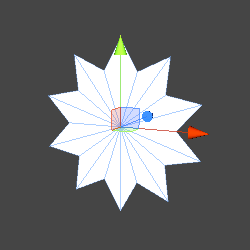
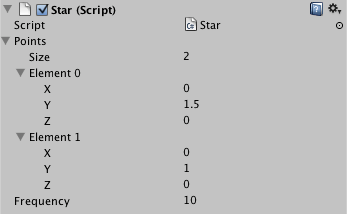
配置好的点
我们需要些颜色!如果把全部的顶点都指定相同的颜色就很简单,但这样太无聊了。我们来试试给每个顶点分配一个颜色。我们需要一个数组来保存这些颜色数据,而且必须保持颜色和顶点的数量一致。这有点小麻烦,我们干脆换成另外一种方式,在Star类中建立一个新的类,这个类可以保存一个顶点的颜色和位置。然后我们可以用这个类的数组来代替vector数组。
这类叫Point,如果在Star类之外使用,就是Star.Point。在Star里面Point就可以了。为了让Unity能够将Point序列化,我们为Point添加System.Serializable特性。
为什么不用结构体?
Because Star.Point is so lightweight and its data is always needed all at once, it would make sense to use a struct type and avoid the overhead that objects add. However, Unity does not support serialization of custom struct types. So you're stuck using classes to bundle data you want to store.
If you're really concerned about the object overhead and possible null errors, you can always store the offset and color data in two separate arrays. However, then you would need to make sure that these arrays always stay synchronized. While that is definitely doable, the class approach is simpler. That's why I use it in this tutorial.
using System; using UnityEngine;
[RequireComponent(typeof(MeshFilter), typeof(MeshRenderer))]
public class Star : MonoBehaviour { [Serializable] public class Point { public Color color; public Vector3 offset; } public Point[] points;
public int frequency = 1;
private Mesh mesh;
private Vector3[] vertices; private Color[] colors; private int[] triangles;
void Start () {
GetComponent<MeshFilter>().mesh = mesh = new Mesh();
mesh.name = "Star Mesh";
if(frequency < 1){
frequency = 1;
}
if(points == null || points.Length == 0){
points = new Point[]{ new Point()};
}
int numberOfPoints = frequency * points.Length;
vertices = new Vector3[numberOfPoints + 1]; colors = new Color[numberOfPoints + 1]; triangles = new int[numberOfPoints * 3];
float angle = -360f / numberOfPoints;
for(int iF = 0, v = 1, t = 1; iF < frequency; iF++){
for(int iP = 0; iP < points.Length; iP += 1, v += 1, t += 3){
vertices[v] = Quaternion.Euler(0f, 0f, angle * (v - 1)) * points[iP].offset; colors[v] = points[iP].color; triangles[t] = v;
triangles[t + 1] = v + 1;
}
}
triangles[triangles.Length - 1] = 1;
mesh.vertices = vertices; mesh.colors = colors; mesh.triangles = triangles;
}
}
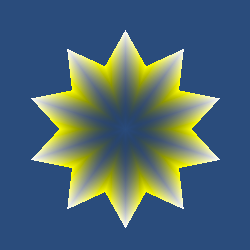
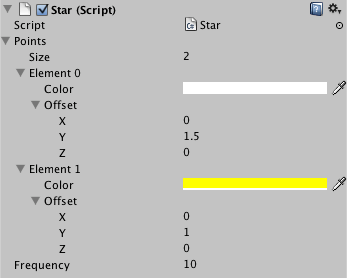
有了颜色之后
最后是关于中心点的。现在,我们还没有给它设置颜色,所以它一直保持着透明。让我们来为它添加一个颜色属性,最终,这个星星看上去变漂亮了。
using System;
using UnityEngine;
[RequireComponent(typeof(MeshFilter), typeof(MeshRenderer))]
public class Star : MonoBehaviour {
[Serializable]
public class Point {
public Color color;
public Vector3 offset;
}
public Point[] points;
public int frequency = 1; public Color centerColor; private Mesh mesh;
private Vector3[] vertices;
private Color[] colors;
private int[] triangles;
void Start () {
GetComponent<MeshFilter>().mesh = mesh = new Mesh();
mesh.name = "Star Mesh";
if(frequency < 1){
frequency = 1;
}
if(points == null || points.Length == 0){
points = new Point[]{ new Point()};
}
int numberOfPoints = frequency * points.Length;
vertices = new Vector3[numberOfPoints + 1];
colors = new Color[numberOfPoints + 1];
triangles = new int[numberOfPoints * 3];
float angle = -360f / numberOfPoints; colors[0] = centerColor; for(int iF = 0, v = 1, t = 1; iF < frequency; iF++){
for(int iP = 0; iP < points.Length; iP += 1, v += 1, t += 3){
vertices[v] = Quaternion.Euler(0f, 0f, angle * (v - 1)) * points[iP].offset;
colors[v] = points[iP].color;
triangles[t] = v;
triangles[t + 1] = v + 1;
}
}
triangles[triangles.Length - 1] = 1;
mesh.vertices = vertices;
mesh.colors = colors;
mesh.triangles = triangles;
}
}
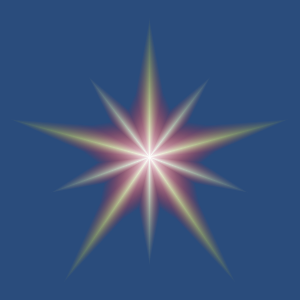
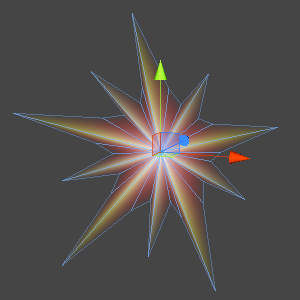
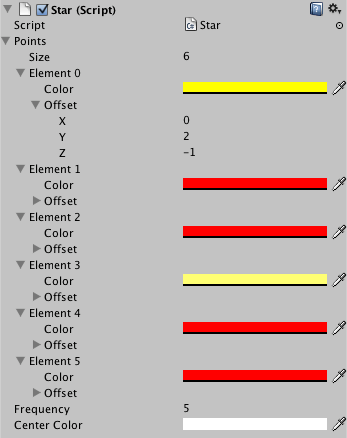
这个教程将让你学会如何创建一个星型控件以及如何制作这个控件的自定义编辑器。你将学会:
- 动态的建立Mesh。
- 使用一个嵌套类。
- 建立一个自定义编辑器。
- 使用SerializedObject。
- 支持所见即所得。
- 对Undo、Redo、Reset和prefab提供支持。
- 支持多对象编辑。
- 支持场景视图内编辑。
我们假设你已经学会了Unity C#的基础编程知识,以及Unity 编辑器的基础知识。如果你已经完成了相关的学习,Let's Go!
建立Star类 Creating the star
我们建立一个全新的Unity工程,然后建立一个新的C#脚本,将它命名为Star。我们将用这个脚本,建立一个由三角面拼接成的星,这里需要一个Mesh。
什么是Mesh?
3D模型是由多边形拼接而成,一个复杂的多边形,实际上是由多个三角面拼接而成。所以一个3D模型的表面是由多个彼此相连的三角面构成。三维空间中,构成这些三角面的点以及三角形的边的集合就是Mesh。
using UnityEngine; public class Star : MonoBehaviour { private Mesh mesh; }
任何对于Mesh的使用,都必须搭配一个MeshFilter组件,而MeshFilter又被用于MeshRenderer组件。只有这样,才能被Unity绘制。所以,这些组件都必须被加载到GameObject对象上,我们的Star对象也必须这么做。当然,我们可以手动添加这些组件,但默认的自动添加是一个更好的办法。所以我们需要添加一个RequireComponent类作为Star对象的一个特性。
什么是类的特性?
特性像对类附加一个标签,用来告诉编译器这个类需要如何处理。是除了类声明的代码之外,对类做的附加说明。另外,特性不止针对类,对方法和属性同样适用。
typeof有什么用?
typeof是一种运算符,能够获得任何类的类型描述数据,数据里最常用的就是类的名字。那为什么不直接在代码里写类的名字就好呢?因为代码中所有的赋值和运算都需要变量,直接使用类的名字会导致编译错误。
using UnityEngine; [RequireComponent(typeof(MeshFilter), typeof(MeshRenderer))] public class Star : MonoBehaviour {
private Mesh mesh;
}
现在,我们建立一个新的空GameObject,将它命名为My First Star,然后拖拽我们的脚本Star到My First Star上。你可以看到,My First Star拥有了两个组件,MeshRenderer和Star。

拖动一个,得到三个
下一个步骤是建立一个Mesh。我们需要在Unity的Start事件里来做这些事,Start事件将在程序启动的时候发生。我们还需要在MeshFilter中给这个新的Mesh起一个名字。
using UnityEngine;
[RequireComponent(typeof(MeshFilter), typeof(MeshRenderer))]
public class Star : MonoBehaviour {
private Mesh mesh; void Start () { GetComponent<MeshFilter>().mesh = mesh = new Mesh(); mesh.name = "Star Mesh"; } }


无编辑器模式与实时预览模式
当然,现在我们在预览模式下还看不到任何东西,因为Mesh还是空的。所以让我们开始编辑顶点数组吧,我们的Star类需要一个用来设置顶点数量的属性,以及这些定点与中心的相对距离。
第一个顶点是Star的中心点,其余的顶点将顺时针排列。我们将使用四元数来计算这些点的排列。因为我们假设俯视Z轴,所以,轮转的角度是负数,否则,将使这些点做逆时针排列。我们不需要设置第一个点,因为vector默认会被设置成0, Mesh中使用本地坐标系。
using UnityEngine;
[RequireComponent(typeof(MeshFilter), typeof(MeshRenderer))]
public class Star : MonoBehaviour { public Vector3 point = Vector3.up; public int numberOfPoints = 10; private Mesh mesh; private Vector3[] vertices; void Start () {
GetComponent<MeshFilter>().mesh = mesh = new Mesh();
mesh.name = "Star Mesh"; vertices = new Vector3[numberOfPoints + 1]; float angle = -360f / numberOfPoints; for(int v = 1; v < vertices.Length; v++){ vertices[v] = Quaternion.Euler(0f, 0f, angle * (v - 1)) * point; } mesh.vertices = vertices; }
}

新的编辑器属性
三角面会被保存成顶点数组,每个面三个顶点。因为我们使用三角形来描述多边形,每个三角形都起始于相同的中点,并且与其他的三角形相连。最后一个三角形与第一个三角形相连。例如,如果有四个三角形,那么顶点数组如下{0, 1, 2, 0, 2, 3, 0, 3, 4, 0, 4, 1}。
using UnityEngine;
[RequireComponent(typeof(MeshFilter), typeof(MeshRenderer))]
public class Star : MonoBehaviour {
public Vector3 point = Vector3.up;
public int numberOfPoints = 10;
private Mesh mesh;
private Vector3[] vertices; private int[] triangles; void Start () {
GetComponent<MeshFilter>().mesh = mesh = new Mesh();
mesh.name = "Star Mesh";
vertices = new Vector3[numberOfPoints + 1]; triangles = new int[numberOfPoints * 3]; float angle = -360f / numberOfPoints;
for(int v = 1, t = 1; v < vertices.Length; v++, t += 3){
vertices[v] = Quaternion.Euler(0f, 0f, angle * (v - 1)) * point; triangles[t] = v; triangles[t + 1] = v + 1; } triangles[triangles.Length - 1] = 1; mesh.vertices = vertices; mesh.triangles = triangles; }
}


一个简单的星星
现在,我们的星星看起来还只是一个简单的多边形。Unity也提示说丢失材质坐标,因为默认的Shader需要这些坐标。我们不会使用一个纹理来描绘所有的星星,让我们通过建立我们自己的Shader来消除这个警告,这个Shader将只使用顶点着色。
我们建立一个新的Shader将它命名为Star,然后写入以下代码。
什么是CGPROGRAM?
Basically, data flows from the Unity engine into the graphics card, where it's processed per vertex. Then interpolated data flows from the vertices down to the individual pixels. In this case, we pass position and color data all the way down. The only additional thing we do is convert vertex positions from world space to screen space.
The statements above the CGPROGRAM switch off default lighting and depth buffer writing. Culling is switched off so we can see the triangles from both sides, not just the front. "Blend SrcAlpha OneMinusSrcAlpha" is default alpha blending, allowing for transparency.
为什么不使用fixed-function shader?
fixed-function shader已经属于过时的技术了。 CGPROGRAM 在将数据转化成屏幕像素方面拥有更强大的功能。
Shader "Star"{
SubShader{
Tags{ "Queue"="Transparent" "IgnoreProjector"="True" "RenderType"="Transparent"}
Blend SrcAlpha OneMinusSrcAlpha
Cull Off
Lighting Off
ZWrite Off
Pass{
CGPROGRAM
#pragma vertex vert
#pragma fragment frag
struct data {
float4 vertex : POSITION;
fixed4 color: COLOR;
};
data vert (data v) {
v.vertex = mul(UNITY_MATRIX_MVP, v.vertex);
return v;
}
fixed4 frag(data f) : COLOR {
return f.color;
}
ENDCG
}
}
}
现在我们建立一个新的材质球,命名为Star,将Shader设置为我们刚刚编写的Star,并且将这个材质球赋予My First Star。


添加材质球之后
顶点着色默认是白色,所以我们的多边形现在变成了白色。我们想要一个更漂亮的星星。所以我们来为每个点定义一种颜色。我们再添加一个frequency属性,这样我们就能让程序自动重复点的序列,而不用我们逐个定义全部的点。这个选项取代了numberOfPoints。
我们在最后需要确认frequency属性是否正确,并且星星至少拥有一个点。如果没有,我们的代码就可能出错。
Why check both for null and the length?
When freshly created, our star component won't have an array yet. It's also technically possible for scripts to explicitly set our array to null later on. We need to watch out for that, to prevent errors. Only if the array does exists do we go ahead and check its length as well.
using UnityEngine;
[RequireComponent(typeof(MeshFilter), typeof(MeshRenderer))]
public class Star : MonoBehaviour { public Vector3[] points; public int frequency = 1; private Mesh mesh;
private Vector3[] vertices;
private int[] triangles;
void Start () {
GetComponent<MeshFilter>().mesh = mesh = new Mesh();
mesh.name = "Star Mesh"; if(frequency < 1){ frequency = 1; } if(points == null || points.Length == 0){ points = new Vector3[]{ Vector3.up}; } int numberOfPoints = frequency * points.Length; vertices = new Vector3[numberOfPoints + 1];
triangles = new int[numberOfPoints * 3];
float angle = -360f / numberOfPoints;
for(int iF = 0, v = 1, t = 1; iF < frequency; iF++){ for(int iP = 0; iP < points.Length; iP += 1, v += 1, t += 3){
vertices[v] = Quaternion.Euler(0f, 0f, angle * (v - 1)) * points[iP];
triangles[t] = v;
triangles[t + 1] = v + 1; } }
triangles[triangles.Length - 1] = 1;
mesh.vertices = vertices;
mesh.triangles = triangles;
}
}


配置好的点
我们需要些颜色!如果把全部的顶点都指定相同的颜色就很简单,但这样太无聊了。我们来试试给每个顶点分配一个颜色。我们需要一个数组来保存这些颜色数据,而且必须保持颜色和顶点的数量一致。这有点小麻烦,我们干脆换成另外一种方式,在Star类中建立一个新的类,这个类可以保存一个顶点的颜色和位置。然后我们可以用这个类的数组来代替vector数组。
这类叫Point,如果在Star类之外使用,就是Star.Point。在Star里面Point就可以了。为了让Unity能够将Point序列化,我们为Point添加System.Serializable特性。
为什么不用结构体?
Because Star.Point is so lightweight and its data is always needed all at once, it would make sense to use a struct type and avoid the overhead that objects add. However, Unity does not support serialization of custom struct types. So you're stuck using classes to bundle data you want to store.
If you're really concerned about the object overhead and possible null errors, you can always store the offset and color data in two separate arrays. However, then you would need to make sure that these arrays always stay synchronized. While that is definitely doable, the class approach is simpler. That's why I use it in this tutorial.
using System; using UnityEngine;
[RequireComponent(typeof(MeshFilter), typeof(MeshRenderer))]
public class Star : MonoBehaviour { [Serializable] public class Point { public Color color; public Vector3 offset; } public Point[] points;
public int frequency = 1;
private Mesh mesh;
private Vector3[] vertices; private Color[] colors; private int[] triangles;
void Start () {
GetComponent<MeshFilter>().mesh = mesh = new Mesh();
mesh.name = "Star Mesh";
if(frequency < 1){
frequency = 1;
}
if(points == null || points.Length == 0){
points = new Point[]{ new Point()};
}
int numberOfPoints = frequency * points.Length;
vertices = new Vector3[numberOfPoints + 1]; colors = new Color[numberOfPoints + 1]; triangles = new int[numberOfPoints * 3];
float angle = -360f / numberOfPoints;
for(int iF = 0, v = 1, t = 1; iF < frequency; iF++){
for(int iP = 0; iP < points.Length; iP += 1, v += 1, t += 3){
vertices[v] = Quaternion.Euler(0f, 0f, angle * (v - 1)) * points[iP].offset; colors[v] = points[iP].color; triangles[t] = v;
triangles[t + 1] = v + 1;
}
}
triangles[triangles.Length - 1] = 1;
mesh.vertices = vertices; mesh.colors = colors; mesh.triangles = triangles;
}
}


有了颜色之后
最后是关于中心点的。现在,我们还没有给它设置颜色,所以它一直保持着透明。让我们来为它添加一个颜色属性,最终,这个星星看上去变漂亮了。
using System;
using UnityEngine;
[RequireComponent(typeof(MeshFilter), typeof(MeshRenderer))]
public class Star : MonoBehaviour {
[Serializable]
public class Point {
public Color color;
public Vector3 offset;
}
public Point[] points;
public int frequency = 1; public Color centerColor; private Mesh mesh;
private Vector3[] vertices;
private Color[] colors;
private int[] triangles;
void Start () {
GetComponent<MeshFilter>().mesh = mesh = new Mesh();
mesh.name = "Star Mesh";
if(frequency < 1){
frequency = 1;
}
if(points == null || points.Length == 0){
points = new Point[]{ new Point()};
}
int numberOfPoints = frequency * points.Length;
vertices = new Vector3[numberOfPoints + 1];
colors = new Color[numberOfPoints + 1];
triangles = new int[numberOfPoints * 3];
float angle = -360f / numberOfPoints; colors[0] = centerColor; for(int iF = 0, v = 1, t = 1; iF < frequency; iF++){
for(int iP = 0; iP < points.Length; iP += 1, v += 1, t += 3){
vertices[v] = Quaternion.Euler(0f, 0f, angle * (v - 1)) * points[iP].offset;
colors[v] = points[iP].color;
triangles[t] = v;
triangles[t + 1] = v + 1;
}
}
triangles[triangles.Length - 1] = 1;
mesh.vertices = vertices;
mesh.colors = colors;
mesh.triangles = triangles;
}
}



漂亮的星星,麻烦的编辑器
Mesh mesh = newMesh();mesh.vertices = objInstace.VertexArray;mesh.triangles = objInstace.TriangleArray;if(objInstace.UVArray.Length > 0) mesh.uv = objInstace.UVArray;if(objInstace.NormalArray.Length>0) mesh.normals = objInstace.NormalArray;mesh.RecalculateBounds();GameObject go = newGameObject();MeshFilter meshFilter = go.AddComponent<MeshFilter>();meshFilter.mesh = mesh;MeshRenderer meshRenderer = go.AddComponent<MeshRenderer>(); 0 0
- unity代码创建mesh
- unity mesh的自定义创建
- Unity 创建一个扇形Mesh
- Unity 动态创建mesh API
- unity 脚本创建 MESH(网格)
- Unity中创建自己的mesh以及动态修改mesh
- Unity中创建自己的mesh以及动态修改mesh
- Unity 3D 创建Mesh(一)
- Unity 3D 创建Mesh(二)
- unity中利用mesh动态创建墙体
- Unity 3D 创建Mesh(一)
- Unity 3D 创建Mesh(二)
- Unity动态绘制曲线Mesh的代码
- Unity Mesh
- Unity Mesh
- Unity Mesh(三) Mesh画球
- 创建mesh
- 创建mesh
- couldn’t be completed. (LaunchServicesError error 0.)
- 汽车VIN码OCR识别
- UIAlertView的按钮颜色设置
- css3 placeholder中含有文字和字符,字符如何在input中垂直居中
- c++中类的学习(二)
- unity代码创建mesh
- 微信开发 JS接口安全域名修改
- 关于ORM框架的简单使用
- Android学习笔记七:sqlite3中的数据类型
- 自定义控件,自定义控件属性declare-styleable
- STM32 OLED显示流程(简略)
- Java Web JavaMail 邮件发送
- 一天的工作从填坑开始
- Unity3D地形引擎指南


